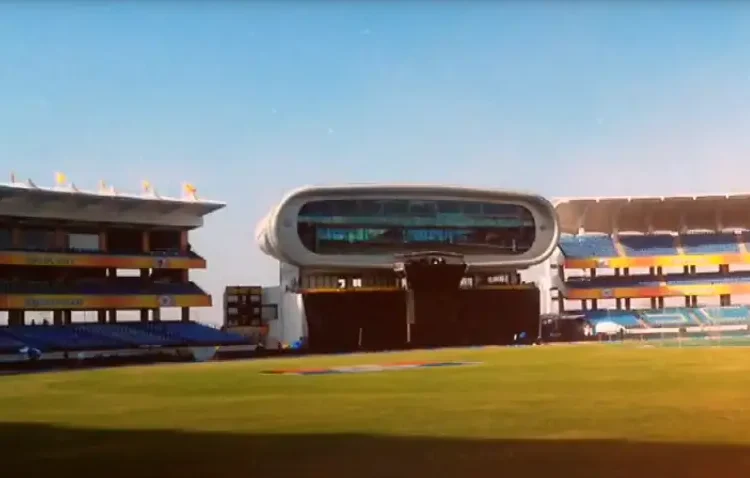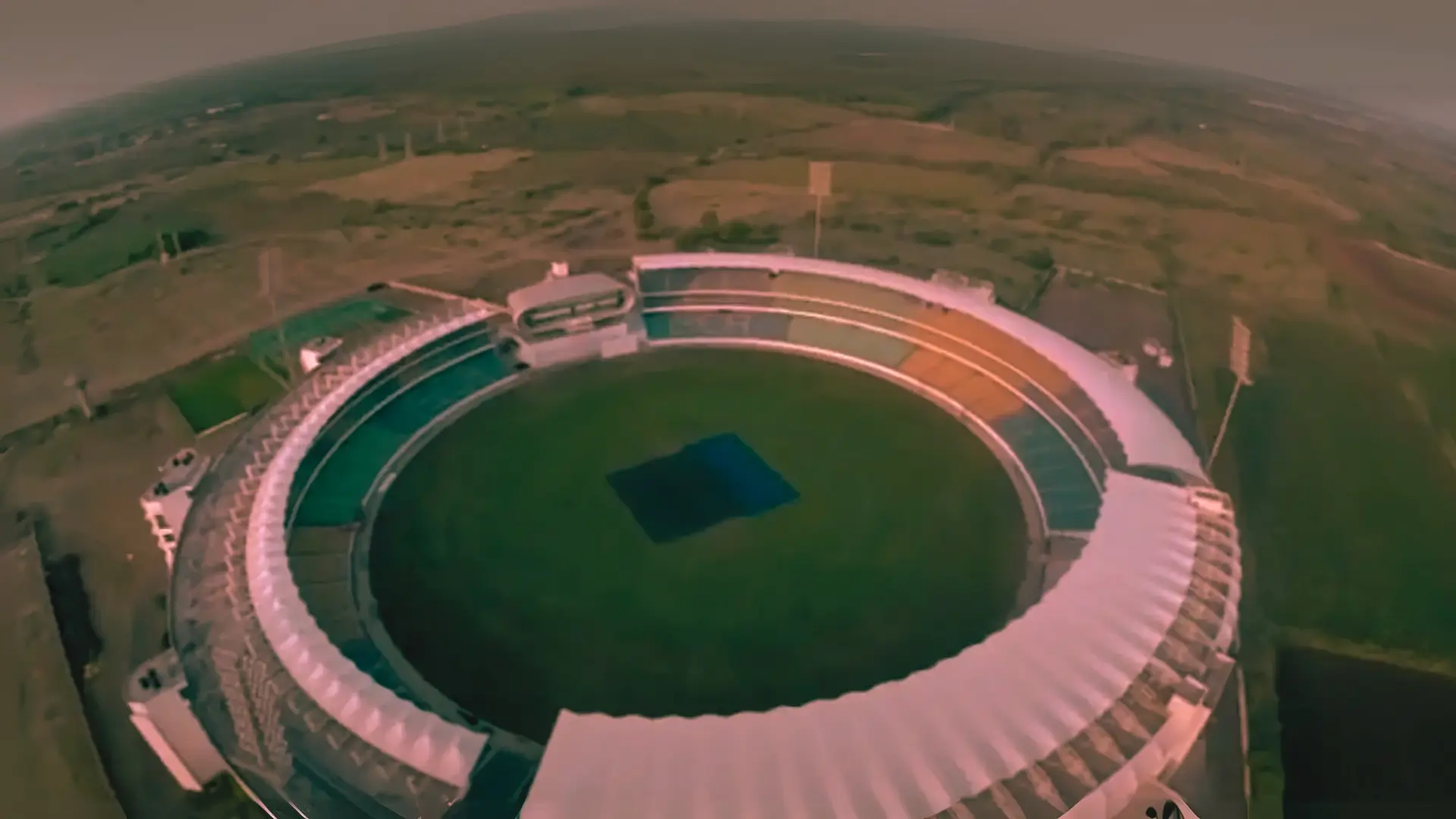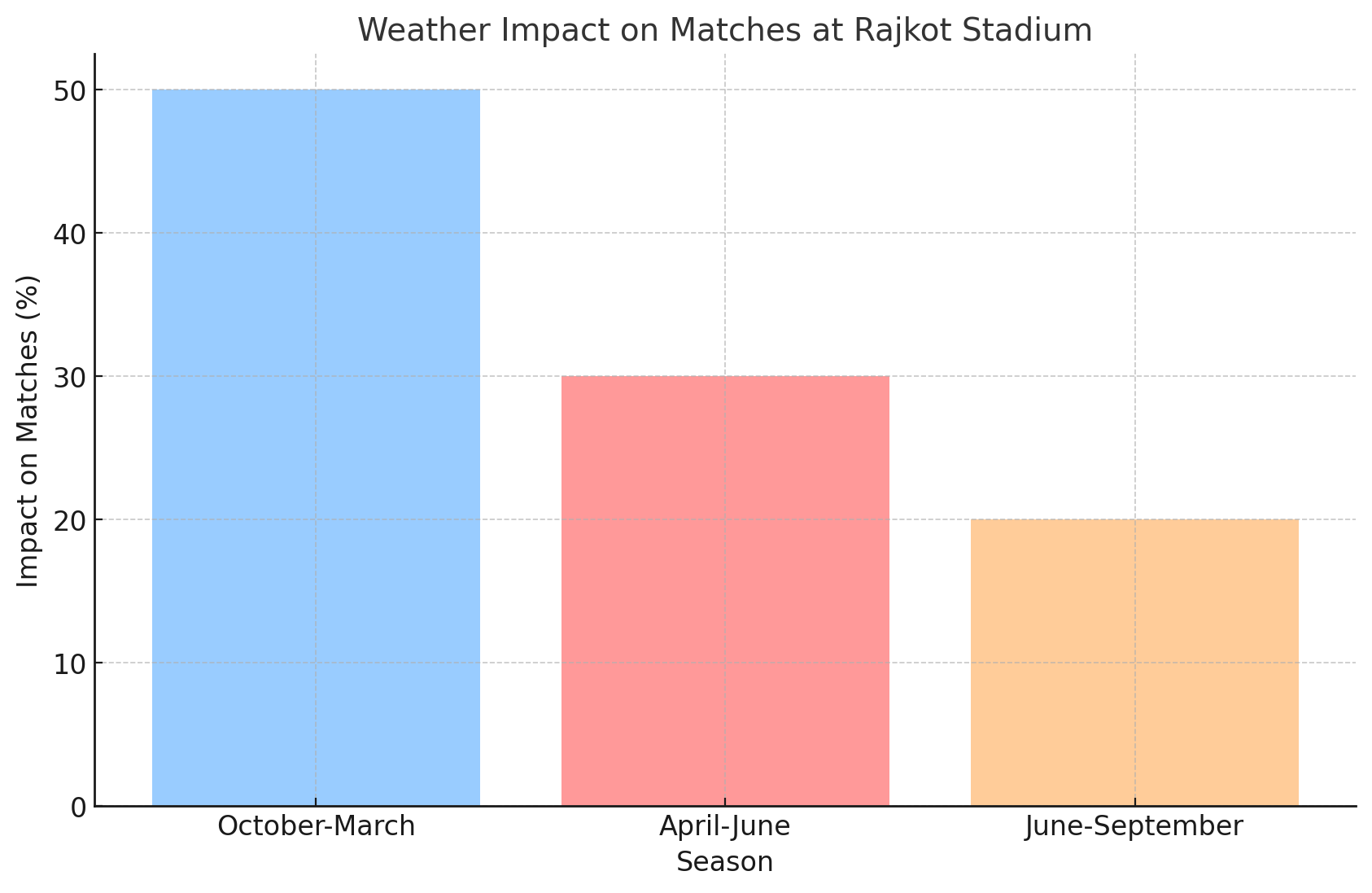Located in Gujarat, India, Rajkot Cricket Stadium features a beautiful architectural approach to how much people love cricket in this part of the world. Over the years, it has evolved into one of India’s top cricketing grounds — thanks to its modern facilities, historical pedigree, and ability to stage big-ticket international games. Rashtrotriya Madhav Rao Scindia Cricket Stadium (International Test and ODI stadium) for Rajkot and Khanderi Cricket Ground (Saurashtra Cricket Association Stadium) isn’t working for Rajkot.
The Saurashtra Cricket Association Stadium has become a hallowed ground with monumental games in domestic tournaments, such as the Ranji Trophy, and international fixtures like ODIs and Test matches.
It is a fan-favorite venue with modern amenities and a 28,000-set capacity. It is also known as Gujarat’s maiden solar-powered stadium, which reasserts the state’s motto of adopting sustainable infrastructure.
As far as the surface is concerned, this one is different in that it comes to the batsman quite well initially before it starts assisting spinners slowly.
Matches at the Rajkot Cricket Stadium only serve to highlight the venue’s stronger name through impressive individual displays and high-scoring encounters. Rajkot Cricket Stadium: A hub of exhilarating cricket matches with a glorious history of cricket in the city, which we will cover at CricketStadium.
Saurashtra Cricket Association Stadium Sports Infrastructure
The stadium has a rich history of fostering sports talent, with cricket playing a pivotal role. The Rajkot cricket grounds, including the historic Madhavrao Scindia Cricket Ground, have nurtured legends like Cheteshwar Pujara and Ravindra Jadeja. These grounds serve as training hubs for young players aspiring to make it big.
Key elements of Rajkot sports infrastructure include:
- World-class stadiums for cricket and other sports.
- Facilities for hosting both domestic and international matches.
- An indoor stadium recognized for its structural excellence.
The city’s focus on sports infrastructure reflects its commitment to promoting physical activity and producing future sports stars.
Key Information About Stadium
| Feature | Details |
|---|---|
| Established Year | 2008 |
| Seating Capacity | 28,000 (planned expansion to 40,000) |
| Location | Khanderi, Rajkot, Gujarat |
| Other Names | Niranjan Shah Stadium, Khanderi Stadium |
| Unique Feature | Solar-powered cricket stadium |
What are the Stadium Features and Facilities?
The Rajkot Cricket Stadium, officially named the Saurashtra Cricket Association Stadium, has a seating capacity of 28,000 spectators. This capacity ensures that the stadium can host large crowds during international matches and domestic tournaments. Plans are underway to expand the seating to 40,000, making it one of the largest cricket venues in India.
The stadium is designed to provide:
- Comfortable seating arrangements: Every spectator enjoys a clear view of the field.
- Spacious lobbies: Easy movement within the stands.
- Dedicated VIP boxes: For corporate guests and cricket officials
Seating Comparison to Other Indian Stadiums
| Stadium Name | City | Capacity |
|---|---|---|
| Saurashtra Cricket Association | Rajkot | 28,000 |
| Wankhede Stadium | Mumbai | 33,000 |
| Eden Gardens | Kolkata | 68,000 |
| Narendra Modi Stadium | Ahmedabad | 132,000 |
Solar-Powered Cricket Stadium in Gujarat
The Rajkot Cricket Stadium is Gujarat’s first solar-powered cricket stadium, reflecting its commitment to sustainability. A solar rooftop system generates electricity, significantly reducing the venue’s energy costs and carbon footprint.
Benefits of Solar Power at Rajkot Stadium:
- Eco-friendly infrastructure.
- Cost-effective energy usage.
- A model for other sports venues in India.
Saurashtra Cricket Association Stadium Boundary Length in Meters
The boundary dimensions of Rajkot Cricket Stadium are crafted to suit both batsmen and bowlers:
- Straight Boundary: Approximately 75 meters.
- Square Boundary: Around 68 meters.
- Longest Boundary: Up to 76 meters.
These dimensions encourage high-scoring matches while allowing bowlers to showcase their skills with smart strategies like M. Chinnaswamy Stadium in Bengaluru.
| Boundary Type | Distance (Meters) |
|---|---|
| Straight Boundary | 75 |
| Square Boundary | 68 |
| Longest Boundary | 76 |
Saurashtra Cricket Association Stadium Records
The Rajkot Cricket Stadium, particularly the Saurashtra Cricket Association Stadium, has been home to several thrilling matches. Here are some key records from Test, ODI, and T20 formats:
| Match Type | Highest Team Score | Lowest Team Score | Top Performers |
|---|---|---|---|
| Test | India: 649/9 vs West Indies | West Indies: 181 vs India | Virat Kohli: 139 runs, Ashwin: 9 wickets |
| ODI | India: 414 vs Sri Lanka | Sri Lanka: 411 vs India | Sehwag-Ganguly partnership: 196 runs |
| T20 | India: 202 vs Australia | N/A | Virat Kohli: 94 runs |
The stadium’s pitch has favored batsmen, leading to high scores and thrilling performances.
Saurashtra Cricket Association Stadium Weather
Majorly the weather in Rajkot significantly impacts match conditions, particularly during cricket seasons. Here’s an overview:
- October to March:
- Cool and dry, making it the ideal period for cricket.
- Daytime temperatures range from 15°C to 30°C.
- April to June:
- Extremely hot and dry, with temperatures reaching up to 40°C.
- Players face challenges like dehydration and fatigue.
- June to September:
- Monsoon season with sporadic rainfall.
- Matches are often interrupted due to wet conditions.
| Season | Weather | Impact on Matches |
|---|---|---|
| October-March | Cool and dry | Best playing conditions. |
| April-June | Hot and dry | Exhausting for players. |
| June-September | Sporadic rains (monsoon) | Matches may face delays. |
Saurashtra Cricket Association Stadium Capacity
The Saurashtra Cricket Association Stadium has a seating capacity of 28,000 spectators, with plans to expand to 40,000. Here’s a comparison with other prominent Indian stadiums:
| Stadium Name | Location | Capacity |
|---|---|---|
| Saurashtra Cricket Association | Rajkot | 28,000 |
| Wankhede Stadium | Mumbai | 33,000 |
| Eden Gardens | Kolkata | 68,000 |
The stadium is designed to provide a seamless spectator experience, with spacious lobbies, VIP boxes, and unobstructed views.
Historical Significance and Major Matches
The Madhavrao Scindia Cricket Ground, also known as Race Course Ground, holds a significant place in the history of cricket in Rajkot. Established in 1935, it has witnessed several remarkable moments in Indian cricket. This stadium was the main cricketing venue in Rajkot until the establishment of the Saurashtra Cricket Association Stadium in 2008.
Key Highlights of Madhavrao Scindia Cricket Ground:
- First International Match: Hosted its first ODI in 1986.
- Notable Records: India’s second-highest ODI total of 414 runs was scored in a match against Sri Lanka in 2009. Sri Lanka scored 411 in response, making it one of the highest aggregate-scoring ODIs ever.
- Spectator Capacity: 15,000.
- Top Performances:
- Virender Sehwag and Sourav Ganguly recorded the highest partnership of 196 runs.
- Tillakaratne Dilshan holds the record for most runs scored by a visiting player.
| Match Type | Key Highlights |
|---|---|
| ODI | India 414 vs Sri Lanka, 2009. Total of 825 runs in the match. |
| Records | Sehwag-Ganguly 196-run partnership. |
| Player Record | Dilshan: Most runs as a visiting player. |
Old Rajkot Cricket Stadium
The Madhavrao Scindia Cricket Ground, often called the Old Rajkot Cricket Stadium, holds a special place in cricket history. Established in 1935, it was the primary cricket venue in Rajkot before the Saurashtra Cricket Association Stadium was constructed.
Key Highlights:
- Hosted its first international ODI in 1986.
- Venue for India’s second-highest ODI score of 414 runs against Sri Lanka in 2009.
- Known for the record-breaking 825 runs scored in a single match during the 2009 ODI between India and Sri Lanka.
| Feature | Details |
|---|---|
| Established Year | 1935 |
| First ODI Hosted | India vs Australia, 1986 |
| Significant Match Highlight | India 414 vs Sri Lanka, 2009 |
Saurashtra Cricket Association Stadium Pitch Report
The pitch report of Rajkot Cricket Stadium showcases its dual nature, making it unique for players and teams. Here’s how the pitch behaves across formats and match days:
- Test Matches:
- Day 1-2: Flat and batting-friendly, ideal for posting high scores.
- On Day 3: Becomes balanced, offering something for both batsmen and bowlers.
- Day 4-5: Starts to deteriorate, favoring spinners significantly.
- ODIs and T20s:
- High-scoring games are common due to the flat nature of the pitch.
- The average first-innings score in ODIs is 322 runs.
- In T20 matches, the average first-innings score is 189 runs.
| Match Format | Pitch Behavior | Impact |
|---|---|---|
| Test (Day 1-2) | Flat, great for batting. | High scores, minimal bowling help. |
| Test (Day 4-5) | Worn out, favors spinners. | Challenging for batsmen. |
| ODIs | Flat, high-scoring games. | Batsmen dominate. |
| T20s | Flat with minimal assistance for bowlers. | Ideal for aggressive batting. |
Saurashtra Cricket Association Stadium Stats
Rajkot Cricket Stadium stats demonstrate its reputation as a high-scoring venue with notable individual and team performances.
Test Matches:
- Highest Team Score: India 649/9 vs West Indies (2018).
- Lowest Team Score: West Indies 181 vs India (2018).
- Most Runs: Virat Kohli and Cheteshwar Pujara (228 runs each).
- Most Wickets: Ravichandran Ashwin (9 wickets).
ODI Matches:
- Highest Team Score: India 414 vs Sri Lanka (2009).
- Memorable Partnerships: Sehwag-Ganguly 196 runs (highest partnership on this ground).
T20 Matches:
- Highest Team Score: India 202/4 vs Australia (2013).
- Most Runs in a Match: Virat Kohli (94 runs).
| Match Format | Top Performance | Record |
|---|---|---|
| Test | India 649/9 | Highest score (2018). |
| ODI | India 414 | Second-highest ODI score (2009). |
| T20 | India 202/4 | High-scoring T20s. |
Rajkot Cricket Stadium Test Records
The Saurashtra Cricket Association Stadium has hosted two Tests to date, and both matches have had unique results:
- India vs England (2016):
- Result: Draw.
- Highlights: England posted 537 runs in the first innings, thanks to centuries from Ben Stokes and Joe Root. India followed with 488 runs, led by Murali Vijay’s century.
- India vs West Indies (2018):
- Result: India won by an innings and 272 runs.
- Highlights: Centuries by Virat Kohli, Prithvi Shaw, and Ravindra Jadeja. West Indies were bowled out for 181 and 196.
| Test Match | Result | Key Highlights |
|---|---|---|
| India vs England (2016) | Draw | Ben Stokes and Joe Root centuries. |
| India vs West Indies (2018) | India won by innings & 272 runs | Kohli, Shaw, Jadeja centuries; Ashwin and Kuldeep’s bowling. |
Rajkot Cricket Stadium T20 Stats
The stadium has hosted several high-scoring T20 matches, showcasing its batsman-friendly nature. Notable T20 matches include:
- India vs Australia (2013):
- India chased down 202 runs successfully, showcasing Virat Kohli’s brilliance with a match-winning knock of 94 runs.
- India vs New Zealand (2017):
- A competitive game where India posted 196 runs, but New Zealand chased it down with two balls to spare.
| Match | Team Scores | Key Performers |
|---|---|---|
| India vs Australia (2013) | India 202/4 | Kohli: 94 runs |
| India vs New Zealand (2017) | NZ 196/5, India 192/4 | Colin Munro: 109 runs |
Rajkot Cricket Stadium Name and New Developments
Saurashtra Cricket Association Stadium is also called the Niranjan Shah Stadium, honoring the former honorary secretary of the Saurashtra Cricket Association. Key developments include:
- Expansion Plans: Increasing seating capacity from 28,000 to 40,000.
- Eco-Friendly Initiatives: Installation of solar panels, making it Gujarat’s first solar-powered stadium.
- Modern Facilities: VIP suites, indoor sports courts, and improved amenities.
| Old Name | New Name | Year Renamed |
|---|---|---|
| Saurashtra Cricket Association Stadium | Niranjan Shah Stadium | 2024 |
Rajkot Cricket Stadium Stats and Old Name
The stadium was formerly known as the Khanderi Cricket Ground before being renamed the Saurashtra Cricket Association Stadium and later Niranjan Shah Stadium. Its stats over the years reflect its status as a premier cricket venue:
| Old Name | New Name | Renaming Year |
|---|---|---|
| Khanderi Cricket Ground | Saurashtra Cricket Association | 2008 |
| Saurashtra Cricket Association | Niranjan Shah Stadium | 2024 |
Notable Statistics:
- Test Matches:
- Highest Team Total: India 649/9 vs West Indies (2018).
- Most Runs: Virat Kohli – 228 runs in 2 matches.
- ODI Matches:
- Highest Team Total: India 414 vs Sri Lanka (2009).
- Most Runs in an ODI: Dilshan (Sri Lanka).
- T20 Matches:
- Highest Team Total: India 202 vs Australia (2013).
- Most Runs in a T20I: Virat Kohli – 94 runs.
How the Solar Rooftop System Works at Niranjan Shah Stadium?
The solar rooftop system at Niranjan Shah Stadium harnesses solar energy to provide a sustainable power source for the venue. Here’s an overview of how it operates:
1. Photovoltaic Technology
Solar Panels: The system consists of photovoltaic (PV) panels installed on the stadium’s roof. These panels are made up of semiconductor materials, typically silicon, which convert sunlight into electricity through the photovoltaic effect. When sunlight hits the panels, it excites electrons in the silicon, generating an electric current.
2. Energy Generation and Usage
Electricity Production: The solar panels generate a significant amount of electricity, contributing to the stadium’s overall power needs. For instance, the system at this stadium produces approximately 82,000 units of solar power annually.
Power Supply: The generated electricity is primarily used to power various facilities within the stadium, including lighting, scoreboards, and other operational needs during events. This reduces reliance on grid electricity and lowers operational costs.
3. Grid Integration
Net Metering: The solar energy produced can be fed back into the grid through a net metering system. This allows the stadium to receive credits for excess energy generated, which can offset future electricity costs.
4. Environmental Impact
Sustainability Goals: By utilizing solar energy, the stadium significantly reduces its carbon footprint and contributes to environmental sustainability. The initiative aligns with broader efforts in India to promote renewable energy sources and reduce dependence on fossil fuels.
5. Future Prospects
Energy Storage Considerations: Currently, the stadium does not have an energy storage system in place, which means it relies on immediate consumption or grid integration for excess energy produced. Future plans may include integrating battery storage to enhance energy independence during night events or power outages1.
The solar rooftop system at Niranjan Shah Stadium exemplifies how sports venues can leverage renewable energy technologies to enhance sustainability while reducing operational costs and environmental impact.
How much energy does the solar rooftop system at the stadium generate annually?
How do you book tickets at Rajkot Cricket Stadium?
- Visit the official Saurashtra Cricket Association website or ticketing platforms like BookMyShow.
- Choose the match, seat category, and number of tickets.
- Complete the payment online or visit the stadium’s ticket counters for offline bookings.
| Ticket Type | Price Range (INR) |
|---|---|
| General Admission | 500-1500 |
| VIP Boxes | 5000-10,000 |
| Corporate Hospitality | Custom Pricing |
Rajkot Cricket Stadium Ticket Price
Ticket prices at the stadium vary depending on the match type, seating area, and demand:
- Domestic Matches: Prices start at INR 500.
- International Matches: General tickets range from INR 1000 to INR 3000.
- VIP and Corporate Boxes: Prices can go up to INR 10,000 or more.
Conclusion
The Rajkot Cricket Stadium’s modern amenities, batsman-friendly pitch, and eco-friendly infrastructure are a cornerstone of Indian cricket. Whether it’s thrilling T20 matches or historic Test games, this venue continues to offer memorable experiences to fans and players alike. Its rich history and commitment to sustainability ensure it remains a top choice for international and domestic tournaments.
The Stadium is a gem in the cricketing crown of Gujarat. From the historical grounds at the Madhavrao Scindia Cricket Ground to the architectural marvel of the Saurashtra Cricket Association Stadium, the city has a storied legacy in Indian cricket history. Famous for hosting exhilarating matches, setting records, and producing cricketing greats, it is a fan-favorite venue.
Rajkot Cricket Stadium is a cricketing hotspot with world-class facilities, sustainable design, and a rich history. With upcoming matches and future happenings, it only seems to keep getting popular and become a key pillar of Indian cricket for times to come.









